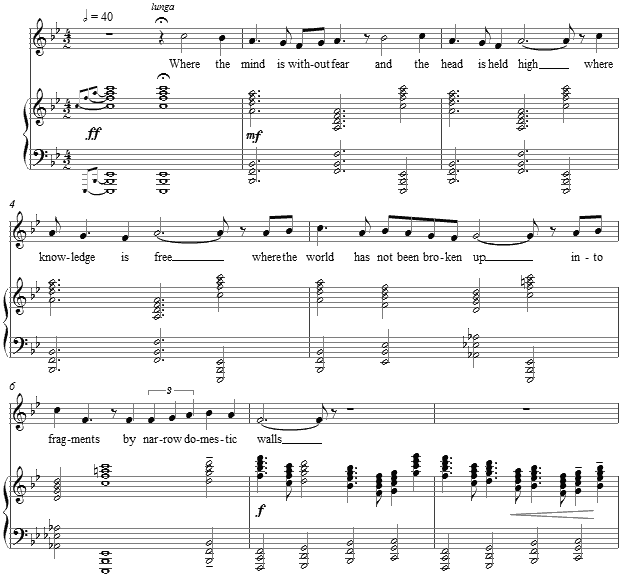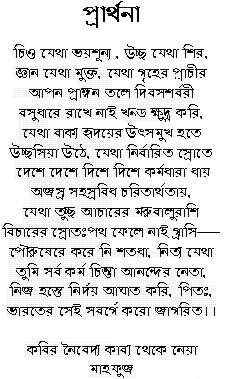Music and Texts of GARY BACHLUND
Vocal Music | Piano | Organ | Chamber Music | Orchestral | Articles and Commentary | Poems and Stories | Miscellany | FAQs
Where The Mind Is Without Fear - (2008)
Rabindranath Tagore
for medium or low voice and piano
Where the mind is without fear and the head is held high;
Where knowledge is free;
Where the world has not been broken up into fragments by narrow domestic wars;
Where words come out from the depth of truth;
Where tireless striving stretches its arms towards perfection;
Where the clear stream of reason has not lost its way into the dreary desert sand of dead habit;
Where the mind is led forward by thee into ever-widening thought and action -
Into that heaven of freedom, my Father, let my country awake.[ 3 pages, circa 3' 30" ]
Rabindranath Tagore
The theme for a number of texts by diverse poets from different lands and different epochs is simple, human freedom; to so many of these texts I am drawn as a composer because freedom is an essential part of the creative life of any artist. The original Bengali poem [ 1 ] which Tagore himself translated as above, was titled "Prayer." This seminal prayer is for freedom, in a world wherein we so often see everything from totalitarianism to blind political correctness stand in opposition to individuality. This text is from Gitanjali, (Offering of Songs), published in English in 1910.
Rabindranath Tagore (1861-1941) was an Indian poet and philosopher. Tagore was born in Calcutta, into a wealthy family, and began to write poetry as a youth with his first book appeared at the age of seventeen. After a brief stay in England (1878) to study law, he returned to India, where he rapidly became the most important and popular author of the British colonial era, writing poetry, short stories, novels, and plays. He composed several hundred popular songs and in 1929 also began painting. He wrote primarily in Bengali, but translated many of his works into English himself. He was awarded the 1913 Nobel Prize in literature, and in 1915 he was knighted by the British king George V, but Tagore renounced his knighthood in 1919 following the Amritsar massacre of Indian demonstrators by British troops. Two of his songs are national anthems of India and Bangladesh.
The structure of the setting is a succession of 3 / 3 / 2 phrases in the accompaniment which break off into the more expected duple meter as noted in the time signature. The light dissonance of the four-note tonic chord is balanced against the more dissonant F over E flat with its fifth included, as the gesture repeats and adds additional tonal vocabulary to the harmonic succession at measure five. The text is interrupted by a broad interlude in the piano.
The culmination of the text is the assertive call for that "heaven of freedom," and with it the setting builds to its greatest climax and a final coda for piano alone -- as we await greater freedom in a corrupting world of men seeking power which does its worst to try to lessen freedom for those who dare to seek it.
The score for Where The Mind Is Without Fear is available as a free PDF download, though any major commercial performance or recording of the work is prohibited without prior arrangement with the composer. Click on the graphic below for this piano-vocal score.
Where The Mind Is Without Fear - medium
Where The Mind Is Without Fear - low
NOTES
[ 1 ] This "Prayer" by Tagore is Bengali:



